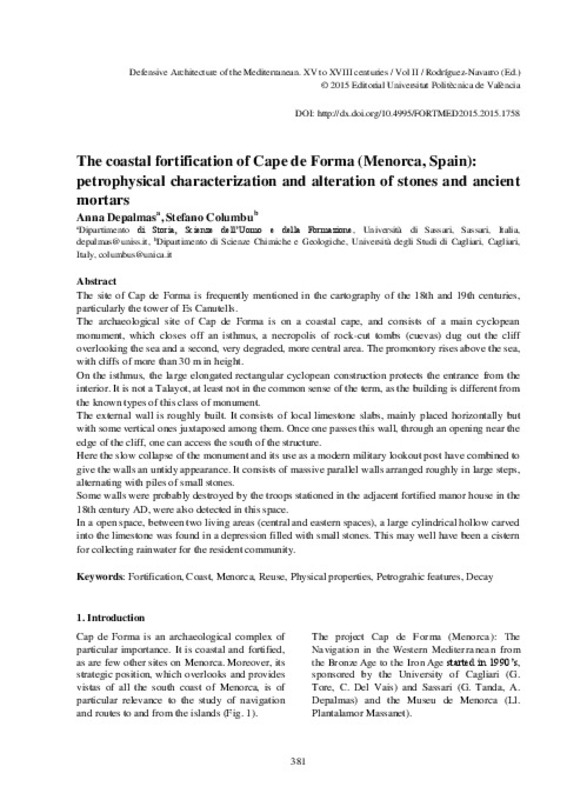JavaScript is disabled for your browser. Some features of this site may not work without it.
Buscar en RiuNet
Listar
Mi cuenta
Estadísticas
Ayuda RiuNet
Admin. UPV
The coastal fortification of Cape de Forma (Menorca, Spain): petrophysical characterization and alteration of stones and ancient mortars
Mostrar el registro sencillo del ítem
Ficheros en el ítem
| dc.contributor.author | Depalmas, Anna
|
es_ES |
| dc.contributor.author | Columbu, Stefano
|
es_ES |
| dc.coverage.spatial | east=4.174887183354144; north=39.843977476251766; name=07712 Maó, Illes Balears, Espanya | |
| dc.date.accessioned | 2018-01-25T10:14:22Z | |
| dc.date.available | 2018-01-25T10:14:22Z | |
| dc.date.issued | 2015-10-16 | |
| dc.identifier.isbn | 9788490483770 | |
| dc.identifier.uri | http://hdl.handle.net/10251/95518 | |
| dc.description.abstract | [EN] The site of Cap de Forma is frequently mentioned in the cartography of the 18th and 19th centuries, particularly the tower of Es Canutells. The archaeological site of Cap de Forma is on a coastal cape, and consists of a main cyclopean monument, which closes off an isthmus, a necropolis of rock-cut tombs (cuevas) dug out the cliff overlooking the sea and a second, very degraded, more central area. The promontory rises above the sea, with cliffs of more than 30 m in height. On the isthmus, the large elongated rectangular cyclopean construction protects the entrance from the interior. It is not a Talayot, at least not in the common sense of the term, as the building is different from the known types of this class of monument. The external wall is roughly built. It consists of local limestone slabs, mainly placed horizontally but with some vertical ones juxtaposed among them. Once one passes this wall, through an opening near the edge of the cliff, one can access the south of the structure. Here the slow collapse of the monument and its use as a modern military lookout post have combined to give the walls an untidy appearance. It consists of massive parallel walls arranged roughly in large steps, alternating with piles of small stones. Some walls were probably destroyed by the troops stationed in the adjacent fortified manor house in the 18th century AD, were also detected in this space. In a open space, between two living areas (central and eastern spaces), a large cylindrical hollow carved into the limestone was found in a depression filled with small stones. This may well have been a cistern for collecting rainwater for the resident community. | es_ES |
| dc.format.extent | 8 | es_ES |
| dc.language | Inglés | es_ES |
| dc.publisher | Editorial Universitat Politècnica de València | es_ES |
| dc.relation.ispartof | Defensive architecture of the mediterranean: XV to XVIII centuries. Vol. II | es_ES |
| dc.rights | Reconocimiento - No comercial - Sin obra derivada (by-nc-nd) | es_ES |
| dc.subject | Fortifications | es_ES |
| dc.subject | Mediterranean | es_ES |
| dc.subject | Modern age | es_ES |
| dc.subject | Built Heritage | es_ES |
| dc.subject | Coast | es_ES |
| dc.subject | Menorca | es_ES |
| dc.subject | Reuse | es_ES |
| dc.subject | Physical properties | es_ES |
| dc.subject | Petrograhic features | es_ES |
| dc.subject | Decay | es_ES |
| dc.title | The coastal fortification of Cape de Forma (Menorca, Spain): petrophysical characterization and alteration of stones and ancient mortars | es_ES |
| dc.type | Capítulo de libro | es_ES |
| dc.type | Comunicación en congreso | es_ES |
| dc.identifier.doi | 10.4995/FORTMED2015.2015.1758 | |
| dc.rights.accessRights | Abierto | es_ES |
| dc.description.bibliographicCitation | Depalmas, A.; Columbu, S. (2015). The coastal fortification of Cape de Forma (Menorca, Spain): petrophysical characterization and alteration of stones and ancient mortars. En Defensive architecture of the mediterranean: XV to XVIII centuries. Vol. II. Editorial Universitat Politècnica de València. 381-388. https://doi.org/10.4995/FORTMED2015.2015.1758 | es_ES |
| dc.description.accrualMethod | OCS | es_ES |
| dc.relation.conferencename | FORTMED2015 - International Conference on Modern Age Fortifications of the Western Mediterranean coast | es_ES |
| dc.relation.conferencedate | October 15-17,2015 | es_ES |
| dc.relation.conferenceplace | Valencia, Spain | es_ES |
| dc.relation.publisherversion | http://ocs.editorial.upv.es/index.php/FORTMED/FORTMED2015/paper/view/1758 | es_ES |
| dc.description.upvformatpinicio | 381 | es_ES |
| dc.description.upvformatpfin | 388 | es_ES |
| dc.type.version | info:eu-repo/semantics/publishedVersion | es_ES |
| dc.relation.pasarela | OCS\1758 | es_ES |








